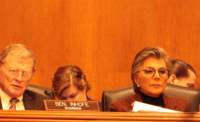WIFIA is launched with $350 million in direct federal aid over five years, with the money split evenly between the Corps and EPA. Annual installments begin at $20 million for each agency in fiscal 2015 and rise to $50 million for each agency in 2019.
The EPA share could go for wastewater-treatment or drinking-water projects. There also is a set-aside for small jurisdictions with populations of fewer than 25,000, a House staffer says.
In addition, the aide says the legislation has provisions to revise policies for EPA's clean waterstate revolving funds (SRFs), which help finance wastewater and drinking-water projects.
A House staffer says that WRRDA doesn't reauthorize the SRF program but includes several provisions “that will make it easier for communities to get SRF loans or make the program work a little better.” For example, the new legislation allows water agencies to take out SRF loans of up to 30 years, compared with a 20-year maximum term now. That permits lower installment payments.
WRRDA also sets a target for increasing spending on dredging projects from the Harbor Maintenance Trust Fund. At present only about half of the fund’s $1.8 billion in income from fees on seaborne freight is spent on dredging work.
The new bill recommends hiking trust-fund spending slightly each year until 2025, when its outgo would equal the trust fund’s annual receipts. It would be up to appropriators to approve annual spending from the harbor fund.
The measure also establishes a National Levee Safety Initiative and boosts dam-safety authorizations, including money for inspections and maintenance, to $9.2 million for each of the next five years, from $6.5 million now.
The reforms Shuster referred to include provisions aimed at accelerating Corps project reviews and approvals. It sets a three-year deadline for Corps feasibility studies and requires federal agencies to carry out their environmental reviews of projects concurrently, rather than in sequence.
The Corps already had set a goal of finishing such studies in three years, for a cost of no more than $3 million, but the WRRDA language would mandate that practice.
WRRDA also changes the authorization process, but Shuster notes that it keeps that authority in the hands of Congress. The legislation calls for annual Corps reports to Congress containing projects that have cleared Army Chief of Engineers’ reviews. It would then be up to the House and Senate to authorize federal funding for those projects.
Lawmakers also altered the funding mix for the Olmsted Locks and Dam project on the Ohio River. At present, the project gets half of its funds from the general fund and half from the Inland Waterways Trust Fund. But as the project’s price tag has risen to $2.9 billion from $775 million in 1987, industry officials have complained that it was drawing too much money away from other worthy projects.
Under the new WRRDA, 85% of Olmsted’s federal aid will come from the general fund and 15% from the waterways trust fund.



